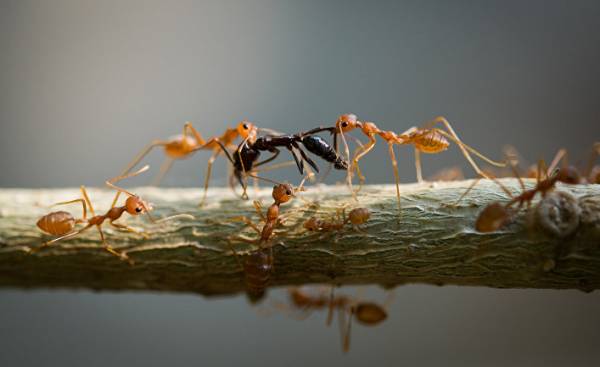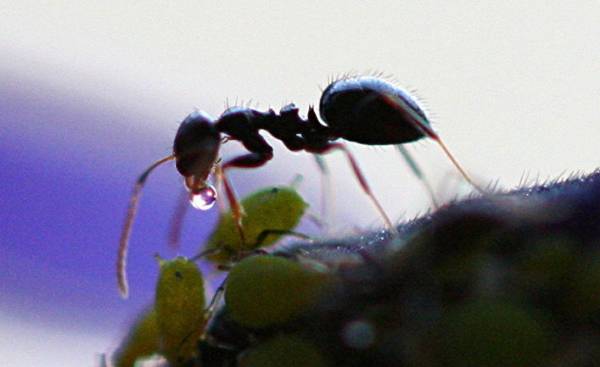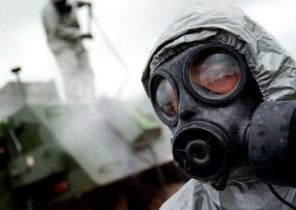
Translation carried out by the project Newочем
If we consider ants as a society, for them there are two options for joining the so-called “war”. One of them is pretty close to normal for people of understanding “war”, namely, the fight between colonies of the same species. The other involves a collision between ants of different species. And both types of conflict are interesting to biologists studying ants.
War of the ants — aggressive form of interaction directly between ants from different colonies. The ants involved in competition with each other. For example, if one of the colonies appropriates a source of food, it is inaccessible to other ants. This is indirect competition. In the context of competition of formic war — a form of conflict where the ants directly enters into fight with each other. Of particular interest to the ants is the fact that such conflicts can occur within one species and between species.
History research
The existence of formic wars knew even before biologists are seriously interested in this phenomenon. For example, the conflict between ants wrote Charles Darwin. For millennia, people have watched with interest for this phenomenon and mentions the success of ants as a society can be found in the Bible. In part, ant war has attracted such attention because of the drama of the battles between the colonies. But, like humans, ants are social, and it is difficult to resist drawing Parallels between our societies. Quite interesting to consider the history of these comparisons as a dialogue: on the one hand, there was interest in the question of whether the struggle between the ants reinforce existing ideas or to open a new side of human conflicts; on the other hand, the possibility of application against ants those doctrines that we have developed for understanding the nature of human conflicts.
Research methods
Ants are social insects. As a rule, in societies insect colony operates as a whole and to some extent retains genetic integrity. In other words, the colony holds a related structure, which is sometimes quite confusing. Within the colony develop the ability to distinguish and recognize each of its members. Ants tend quite simply to divide the world into two classes: the members of the colony and all the rest. Within the colony produced a very bright distinctive features, designed to unite it. At least in most species and under most circumstances.
Ants often encounter other ants, especially in the tropics. A recent study conducted in the Appalachian mountains in the United States, showed how tightly can settle the ants. The researchers collected dead insects in the woods, left them on the ground and watched how much time will pass before the food will reach a potential predator or concument. Most of these pieces of food were found by the ants, and they never took more than a couple of minutes. In those places where the nests closest to the ground, the ants continually review and patrol the grounds, leaving untouched for a long time areas.
Thus, ants are likely to encounter members of other colonies, and sometimes that of other species. In the habitats occupied from many species, the probability of collision cross-species colonies is extremely high. This interaction occurs regularly. If the colony understands that there is a threat of loss of resources or territory on the part of other ants and ants from other colonies of the same species, this threat should be an organized, aggressive response, which can sometimes result in a real battle.
The evolution of weapons
Ants are ancient insects, they existed long before the split of the supercontinent Gondwana. It happened more than a hundred million years ago, and the ants appeared long before that. Of course, the ants engage in war for many tens, if not hundreds, of millions of years. Ants have a number of tools that they can apply during the fight. We can assume that the war played a very important role in their evolution. Scientists studying the process of their evolution, explain the change of the object of aggression as their development. In the past, the main enemies of the early ants were vertebrates (such large land animals like dinosaurs, birds and mammals). Many kinds of ants was equipped with a very powerful sting — and they were very well adapted to attack humans, but their “weapon” was not very effective against other insects.
As soon as the ants have evolved and their types became more diverse, the impact of these species on each other was becoming more and more significant. This was the reason that the place of the main enemies ants occupied by other ants. It would seem that this is contrary to common sense, but some kinds of ants have lost their sting. In many cases the sting has transformed into a system of supplying chemical weapons that were successfully used in the fight against other ants. It looks as if the ants intentionally declined the opportunity of fighting with vertebrates like us in favor of the ability to attack, to fight back and win in the confrontation with the other ants.
Now, many kinds of ants have a special Arsenal of weapons, which is not very effective against mammals, but works well against other ants. Details such as place in the body of an ant, which produces the chemicals, and what chemicals are used, are quite different among different species. Looking at the different kinds of ants, you will notice that the special glands that are used during the ant fights, can be literally in any part of the body. Chemical compounds is also highly diverse. In the course of evolution each species developed independently, and such a difference in weaponry, you can understand how in different ways they approached solving the problem.
Ants have many types of weapons. Usually applied bites. Often, the ants work together — members of the attacking colonies can hold members of another colony or ants independently break into pieces at that time as their relatives delay the enemy. In fact, ants are very nasty. There is at least one species in which worker ants in the body has a very large iron. If these ants are quite strong uneasy, they can increase the pressure on her and literally explode, spattering all around a gooey substance. Other ants also have a variety of glands located sometimes in the head, and sometimes in the abdomen and secreting toxic substances that bring down their enemies. Thus, their conflicts include methods starting with fights and ending with a chemical weapon that unites them with people.
Make love, not war
There is an interesting phenomenon that is almost certainly linked to human-produced changes in the natural environment. The invasion of invasive species have occurred repeatedly around the world. When introduced by man kind gets the opportunity to learn a new environment, it can multiply to unimaginable proportions, reaching unprecedented in its native habitat density. The distribution of invasive ant species can reach huge areas of thousands of square kilometers.
Why these intrusions reach such success? The benefits of the biology of these species are associated with the loss of some species, for one reason or another, the ability to distinguish the boundaries of the colonies. Under normal conditions, each colony has its own chemical signature, which the ants distinguish between their own and others. But many invasive species have lost it. In his view they behave with other individuals as though they are members of their own colony.
 © Wikipedia, Dawidi, JohannesburgМуравей collect honeydew of aphids
© Wikipedia, Dawidi, JohannesburgМуравей collect honeydew of aphids
The ability to avoid formic wars within species and willingness to take on members of other colonies to their own helped to reduce costs. So they were able to increase the size of the population and become more successful in the competition. They retain the ability to consider other species as enemies or strangers but do not show intraspecific aggression. As a result, almost one ant colony extends for thousands of kilometers. Ants with one of its edges without any aggression to interact with ants from another. This effect was observed repeatedly and is quite astonishing. The types that had been successful in invasions did not involve a close relationship and come from different subfamilies of ants, which makes them very diverse.
This tells us that cooperation is the right path to success. Of course, much depends on the level at which it is expressed. We can again turn to the comparison between ants and human society. People are social animals: we work together, we form alliances. But a colony of ants have that level of cooperation and integration, which is virtually unattainable for a person. The person is almost always different from the ant that even existing in the family or another social group retains a significant part of individual identity.
We are always with great excitement perceived instances of self-sacrifice and generosity, and ultimately our life is in a delicate maneuvering between selfishness and cooperation. In this sense, the ants are different from us. Within the colony selfishness and individual interests to a greater extent ceased to exist. The ants continue to cause conflicts between the different colonies, but interestingly, abandon barriers of colonies of invasive species, appear to achieve greater success.
Soldiers against nomadic ants
Soldiers are a special type of ants are found in colonies of some species. They are part of the workforce and spetsializiruyutsya on defense. Not all species of ants have soldiers, most limited to only one type of workers. But other specialized types of soldiers are different from ordinary workers increased body size and behavior. If the colony is attacked, it is the soldiers take the major part in its defense.
Army ants (hereafter KM) is a subfamily of ants whose members have several unique behaviors. They developed their social skills are stronger than any other group of social insects or even any other kind of animal known to us. KM, interesting because of their features do all the steps together. Any activity carried out in close cooperation of large groups of individuals. They don’t commit solely of independent action and individual workers never go by themselves.
The only members of the colonies KM, which are able to act independently is male. From time to time they are born colony for mating; for search young females outside the colony they have wings. Any other activity in the colonies of the KM is performed by a group consisting of members of the same nest. Among them there are individual scouts or foragers. All done by a mass swarm of insects. You’d think a colony of KM is an indivisible unit, almost like an organism, like the amoeba Mononoke. Like Reid MILES for the sake of finding food is an arm or leg, never losing connection with the body. And all they’re doing is with a high degree of coordination and interaction.
Army ants provide an excellent material for the study of the formic wars. They are also a bit different from all the other ants. For them the world is divided into 3 categories: other colonies of the same species, other types of KM and other animals (including other species of ants, not being nomadic). Their reaction to each of the categories are quite different. Overall, KM does not participate in the formic wars with other KM. However, one of the favorite victims for MILES are other types of ants.
Nomadic ants with larvae from a ravaged hornet’s nest
Between related to KM types there are two types of reactions: ignoring or avoiding. Imagine the process of furazhirovki KM: they send a large RAID group, a carpet of ants-workers, speeding through the forest. Sometimes these approaches Roy Roy the representatives of the other species KM. In such a situation we expect to see an exciting battle between two masses KM. However, they often simply ignore each other: two huge swarm safely pass through each other. The appearance of this phenomenon is truly amazing.
Another type of reaction is very rare. When two colonies of the same species MILES come in contact, they quickly recognize that he had met with members of the other group. But instead of starting the battle, the two colonies retreating in opposite to each other direction. They are ready to overcome relatively large distances, as much as possible to move away from each other, which can lead to even shift throughout the colony. Thus, in his view of KM show a clear avoidance, and the members of different species just ignore each other.
When MILES confronted with the representatives of the other, not the nomadic kind of ants, the opposite occurs: they almost certainly will attack and try to kill each ant of the colony. KM attack very large colonies of other ant species, viewing them as prey. Of course, other ants in many cases give them back. This may result in heavy losses on both sides. The war between the colonies KM and their victims are amongst the most spectacular and catastrophic battles in nature. Most often, AWAY win, but they can suffer huge losses during the battle.
KM is able to recruit a large number of their fellows in the nest, when they find any valuable resource. There is evidence that they have special substances for use in such cases rekrutierung pheromone. This is an area for new research KM and their chemical instrumentation. It was experimentally discovered that they have functionally different pheromones and chemical signals for communication of various information, but we know almost nothing about their specific chemical composition.
From the point of view of physical dimensions, KM is not always very large. There are many other ant species with a much larger body size than KM. But the success they achieve because of the quantity. Their colonies are huge, and all actions are performed in large coordinated groups. If you are faced with the representatives of the colony of AWAY, it is not about one scout, and from significant parts of the colony. At the same time there are many individuals that need to struggle and, unlike other ants, they don’t have to wait until the completion of recruitment. They interact with all elements of the environment as a distinct social unit.
Army ants vs ants leaf cutter
One of the varieties of KM in the tropical forests of the New world regularly attempts to encroach on the territory of developed colonies of ants leaf cutter. KM and leaf-cutter ants — ant crowns of evolution: they can create vast colonies, to achieve a high level of socialization and participate in a multifaceted division of labour. When MILES attacked the highly developed population of ants leaf cutter, the soldiers of both species are arranged opposite each other and begin a catastrophic battle, which can last for days, while KM does not break through the defense line, get to the nests of leaf cutter and begin to plunder their reserves.
Leaf-cutter ants build huge nests and establish vast colonies with millions of inhabitants. Soldiers ants of this species are remarkably large: the capacity of ant-a soldier is hundreds of times higher than that of an ant worker. However, soldiers can’t perform a large amount of work for the colony: they are too massive, their maintenance is costly population, and the exact purpose is still not to be a mystery for biologists.
However, when biologists specializing in the study of KM began to observe regular attacks KM on ant colony of leaf cutter, they noticed a leaf cutter react to these intrusions. Thousands of a huge leaf cutter soldiers went to the front where they had to try to repel KM. In most cases, their efforts were unsuccessful, and ultimately KM still broke through the defense line. However, we can assume that the protection from KM is the reason for existence of leaf cutter soldiers. This observation reinforces the theory that the war or battle with other ants represent an important aspect of ant evolution.
If you look closely at how the other ants respond to the attack KM, we can distinguish a wide range of reactions. Some species of ants are trying to fight back, others start to panic, seeing the first soldiers AWAY, and rush to save the nest. Usually they’re evacuating the offspring and trying to move at the greatest possible distance. Feeling safe, they stop and wait. Once sated, AWAY leaving the devastated colony, the victims of the attack to return home.
Modern research
Currently, the biological characteristics of invasive ant species are of considerable interest. Scientists began to understand that the information that gets involved if one or the other colony in a collision, helps us to learn more about biological invasions and their possible negative consequences. Some species of invasive ants cause environmental problems on a global scale — not only for humans, but for ecosystems undermined their invasion. Given that they erase from the face of the endangered species and their behavior contribute to changing the structure of the habitat, they can be terrible on the scale effect on the environment.
They also pose a problem for people: these ants get into the food, some species exude an unpleasant odor, cause disease. Understanding ant wars may be the key to detect features inherent to invasive species of ants and provoking such behavior. Probably this discovery will help us develop a response to formic demarches, or even to predict when something like this happens again. Therefore, today there are a lot of studies of aggression and formic formic wars, which is expected to give an answer to the question of biological invasions.
A good idea would be to take a closer look at the types of animals that are directly benefitting from ant wars. In the colonies many subspecies of ants live representatives of other types, called “myrmecophiles” (organisms living in Association with ants and some time (temporarily or permanently) that depend on them — approx. Newочем). These representatives of the animal world make a living mainly due to the ant colony. Usually we are talking about parasites, but their negative impact on the life of the colony is usually minimal. Myrmecophily develop ability to hide from ants. Adopted in colony recognition mechanism countrymen does not apply to them, but they somehow bypassed it. A species whose destiny is tied to the fate of the ant colony in evolutionary terms, demonstrate a live interest in the outcome of the formic wars. In other words, if the colony is ruined, they also have hard times. However, at the moment scientists do not have information on the direct participation of myrmecophiles in battle. Although the idea is not bad.
In my lab we are now working in two directions. First, we examine the evolution of the ant’s brain in an attempt to understand how the nervous system responds to different environmental conditions, determines whether it is social roles and body size of ants. Second, we are interested in understanding how to use KM to study the temperature variations and possible impacts of climate change on the genetics and psychology of the animal world. We believe KM is an excellent model for the study, partly because the representatives of the subspecies KM, common in the tropics, can withstand wide temperature range: identical subtypes in the studies were exposed to very high temperatures in low-lying areas and very low in the mountains.
Unresolved issues
From the barrage of scientific articles that have appeared in 2015, we learned that the structure of the ant’s brain in recent times has undergone significant changes, particularly in the aspect of transformation of the species of entomophage in social creatures. This change theoretically supports the hypothesis that becoming a social creature, a member of the species does not require the same high level of development of the brain and cognitive activity, because now he can share information and integrate with other members of its subspecies. Almost as if neural connections may be inferred at the group level. This discovery was a breakthrough; it is necessary to analyse similar tendencies in other species, to understand whether it applies to all fauna. This is important because, if you look at the members of the class of vertebrates — mammals, birds, fish — most of them basically shows the opposite trend. In other words, if your appearance becomes more socialized, brain activity increases as well; insects demonstrate the opposite dependence. This direction of research can be fraught with many exciting discoveries.
Open questions remain about mega-colonies, which we have already talked earlier. How deep is existing in them integration? Perhaps all limited to local level and they share information only for small distances. It is interesting to imagine deeply integrated colony, although it is unlikely that they are able to share information at great distances. However, it is a good idea for a sci-Fi novel.
Sean O’donnell, PhD; Deputy Dean, Professor, Department of biodiversity, Earth and environmental studies Drechselschule University.







